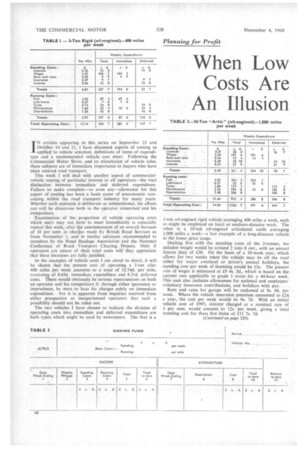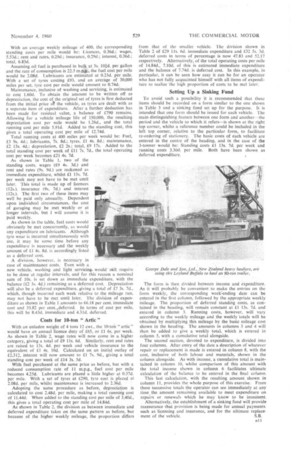When Low Costs Are An Illusion
Page 82

Page 85

If you've noticed an error in this article please click here to report it so we can fix it.
IN articles appearing in this series on September 23 and October 14 and 21, I have discussed aspects of costing as applied to vehicle selection, definitions of items of expenditure and a recommended vehicle cost sheet. Following the Commercial Motor Show, and its stimulation of vehicle safes, these subjects are of immediate importance to buyers who have since entered road transport,
This week I will deal with another aspect of commercialvehicle costing of Particular interest to all operators-the vital distinction between immediate and deferred expenditure. Failure to make complete-or even any-allowance for this aspect of costing has been a basic cause of uneconomic ratecutting within the road transport industry for Many years. Whether such omission is deliberate or unintentional, the effects can still be disastrous both to the operator concerned and his competitors. .
Examination of the proportion of vehicle operating costs which users may not have to meet immediately is especially topical this week, after the announcement of an overall Increase of 10 per 'cent, in charges made by British Road Services as from November 1,and in similar advances recommended to members by the Road Haulage Association and the National Conference of Road Transport Clearing Houses. Only if operators are aware of their total costs will they appreciate that these increases are .fully justified.
In the examples of vehicle costs J am about to detail, it will be shown that the present cost of operating a 3-ton oiler 400 miles per week amounts to a total of 12.74d. per mile, consisting of 8.43d. immediate expenditure and 4.31d. deferred costs. There would obviously be serious repercussions on both an operator and his competitors if, through either ignorance or imprudence, he were to base his charges solely on immediate expenditure. Yet it is apparent from inquiries received from either. prospective or inexperienced operators that such a possibility should not be ruled out.
The two vehicles I have chosen to indicate the division of operating costs into immediate and deferred expenditure are both types which might be used by newcomers. The first is a 3-ton oil-engined rigid vehicle averaging 400 miles .á week, such as might be employed on local or medium-distance work. The other is a 10-ton oil-engined articulated outfit averaging 1,000 miles a week-a fair example of a long-distance vehicle in the lower price range.
Dealing first .with the standing costs of the .3-tonner, the unladen weight would be around 2 tons 8 cwt., with an annual licence duty of £30. On the basis of a 50-week year, which allows for two weeks when the vehicle may be off the road either for major overhaul or driver's annual holidays, the . standing cost per week of licensing would be 12s. The present rate of wages is estimated at £9 4s. 3d., which is -based on the current rate applicable to grade I areas for a 44-hour week. This sum also includes allowances for national and employers' voluntary insurance contributions, and holidays with pay.
Rent and rates for garage will be reckoned at 9s. 9d. per week. Where the vehicle insurance premium amounted to £24 a year, the cost per week Would be 9s. 7d. With an initial vehicle cost of £995, interest charged at a nominal rate of 3 per cent, would amount to 12s, per week, giving a total . standing cost for these five items of £11 7s.7d.
With an average weekly mileage of .400, the corresponding standing costs per mile would be; Licences, 0.36d.; wages, 5.53d.; rent and rates, 0.29d.; insurance, 0.29d.; interest, 0.36d.; total, 6.83d.
Assuming oil fuel is purchased in bulk at 35. 10d. per gallon and the rate of consumption is 22.5 m.p4, the fuel cost per mile would be 2.08d. Lubricants are estimated at 0.23d. per mile. With a set of tyres costing £93, and an average of 30,000 miles per set, tyre cost per mile would amount to 0.74d. Maintenance, inclusive of washing and servicing, is estimated to cost 1.60d. To Obtain the amount to be written off as depreciation, the cost of the original set of tyres is first deducted from the initial price of the vehicle, as tyres are dealt with as a separate item of expenditure. After a further deduction has been made for residual value, a balance of £790 remains. Allowing for a vehicle mileage life of 150,000, the resulting depreciation cost per mile would be I.26d., and the total running cost per mile 5.91d. Added to the standing cost, this gives a total operating cost per mile of 12.74d. Total running costs at 400 miles per week would be: Fuel, £3 9s, 4d.; lubricants, 75. 8d.;. tyres, £1 4s. 8d.; maintenance, £2 13s. 4d.; depreciation, £2 2s.; total, £9 17s. Added to the total standing cost per week of El 1 7s. 7d., the total operating cost per week becomes £21 4s. 7d.
As shown in Table I, two of the standing costs, wages (£9 4s. 3d.) and rent and rates (9s. 9d.) are reckoned as immediate expenditure, whilst £1 13s. 7d. per week may not have to be met until later, This total is made up of licences (12s.), insurance (9s. 7d.) and interest (12s.). The first two of these items may well be paid only annually. Dependent upon individual circumstances, the cost of garaging may be met weekly or at longer intervals, but I will assume it is paid weekly.
As shown in the table, fuel costs would obviously be met concurrently, as would any expenditure on lubricants. Although Lyre wear is incurred simultaneously with use, it may be some time before any expenditure is necessary and the weekly amount of £1 4s. 8d. is accordingly. listed. as a deferred cost.
A division, however, is necessary in case of maintenance costs. Even with a• new vehicle, washing and light .sgrvicinw would skil require to be done at regular intervals, and for this reason a nominal sum of 10s. is set down as immediate expenditure, with the balance (£2 3s. 4d.) remaining as a deferred cost. .Depreciation will also be a deferred expenditure, giving a total of £7 3s. 7d., which, though incurred each week relative to the mileage run, may not have to be• met until later. The division of expenditure as shown in Table 1 amounts to 66.18 per cent immediate cost and 33.82 per eent_deferred, In terms of cost per mile, this will be 8.43d. immediate and 4.31d. deferred.
Costs for 10-ton 5' Artie" With an unladen weight of 4 tons 12 cwt., the 10-ton " mile" would have an annual licence duty of £65, or El 6s. per week.
As shown in Table 2, wage rates will now come in a. higher category, giving a total of £9 1 Is. 6d. Similarly, rent and rates are raised to 13s, 4d. per week and vehicle insurance to the equivalent of ,.£1. 4s, 10d, Calculated on an initial outlay of £2,312, interest will now amount to £1 7s. 9d., giving a total standing cost per -week of £14 3s. 5d.
With fuel purchased at the same price as before, but with a reduced consumption rate of 11 m.p.g., fuel cost per mile becomes 4.25d. Lubricants are placed a little higher at 0.37d. per mile. With a set of tyres at £290, tyre cost is placed at
2.08d. per mile, whilst maintenance is increased to 2.360. • Adopting the same procedure as before, depreciation is calculated to cost 2.48c1. per mile, making a total running cost of 11.44d. When added to the standing cost per mile of 3.40d., this gives a total operating cost per mile of 14.84d.
As shown in Table 2, the division as between immediate and deferred expenditure takes on the same pattern as before, but because of the higher weekly mileage, the proportion differs from that of the smaller vehicle. The division shown in Table 2 of £29 1 ls, 6d, immediate expenditure and £32 5s. 3d. deferred costs in terms of percentage is now 47.83 and 52.17 respectively. Alternatively, of the total operating costs per mile of 14.84d., 7.10d. of this is estimated immediate expenditure and the balance of 7,74d. is deferred cost. In this example, in particular, it can be seen how easy it can be for an operator who has not fully acquainted himself with all items of expenditure to realize the high proportion of costs to be met later.
Setting Up a Sinking Fund To avoid such a possibility it is recommended that these items should be recorded on a form similar to the one shown in Table 3 and a sinking fund set up for the purpose. It is intended that-one form should be issued for each vehicle. The main distinguishing feature between one form and another--the period and the vehicle to which it refers-is shown at the right top corner, whilst a reference number could be included in the left top corner, relative to the particular form, to facilitate re-ordering of stationery. The basic costs of each vehicle are entered in the centre of the heading, and in the case of the 3-tonner would be: Standing costs £1 13s. 7d. per week and running costs 3.30d. per mile. Both have been shown as deferred expenditure, The form is then divided between income and expenditure. As it will probably be convenient to make the entries on the form weekly, the corresponding week-ending date can be entered in the first column, followed by the appropriate weekly Mileage. The proportion of deferred standing costs, as contained in the heading, will remain constant at £1 13s. 7d. and entered in column 3. Running costs, however, will vary according to the weekly Mileage and the weekly 'totals will be obtained by multiplying this mileage by the basic mileage cost shown in the heading. The amounts in columns 3 and 4 will then be added to give a weekly total, which is entered in column 5, with a cumulative total alongside.
The second section, devoted to expenditure, is divided into four columns. After entry, of the date .a description of whatever repair or replacement is made is entered in column 8, with the cost, inclusive of both -labour and materials, shown in the column alongside. As with income, a cumulative total is maintained in column 10, whilst comparison of this amount with the total income shown in column 6 facilitates ultimate calculation of the balance to be entered in the final column.
This last calculation, with the resulting amount shown in column 11, provides the whole purpose of this exercise. From these successive totals the operator can see immediately at any
time the, amount remaining available to meet expenditure on repairs or renewals which he may know to be imminent. . Alternatively, the establishment of a sinking fund will provide reassurance that provision is being made for annual payments. such as licensing and insurance, and for the ultimate replace
ment of the vehicle. S.B.
























































































































